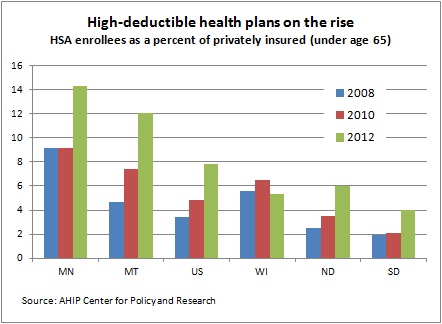Over the past decade, high-deductible health insurance plans have caught on with firms as a way to reduce the costs of providing health care benefits—primarily by shifting a larger share of medical expenses to employees. These plans include health savings accounts, tax-exempt funds owned by employees that can be used to pay for medical care.
A recent annual survey by America’s Health Insurance Plans, a national trade association, found that HSAs provided coverage for more than 13.5 million people in the United States—about 8 percent of total private insurance enrollment. That’s a marked increase since 2008, and most states in the Ninth District mirror the trend (see chart, at bottom).
The recession and a tepid recovery have had something to do with those increases; cash-strapped employers have turned to high-deductible health plans as an antidote to rising insurance premiums. But the AHIP data reveal considerable variation among Ninth District states in participation in such plans—differences that are difficult to attribute to the downturn or a general rise in premiums.
As of January, 487,000 Minnesotans—roughly 14 percent of private insurance enrollees in the state—were covered by an HSA. In Minnesota and Montana, HSAs accounted for a bigger share of private health insurance coverage than in the country as a whole. However, in other district states, HSA participation rates were lower than the national average.
Some of the divergence in HSA uptake among district states may be a statistical fluke; in this year’s survey, over 2.7 million people nationwide were not assigned to any state because some health plans missed AHIP’s reporting deadline. But health care experts point to differences in health care models and average business size across states as possible explanations.
“Minnesota was an early proponent of high-deductible health plans” in the early 2000s, giving it a head start in HSA growth, said Stephen Parente, a professor of health finance at the University of Minnesota. And Parente notes that a large share of Montana employers are small businesses with fewer than 50 workers. Small firms paying relatively high small-group premiums tend to offer less comprehensive health coverage than big firms.
Less aggressive marketing of HSAs by insurers and a greater emphasis on managed care in clinics may partly account for lower participation rates in Wisconsin and the Dakotas.






